2009 Corvette ZR1 Powered By The Most Powerful Production Engine Ever From GM: The Supercharged LS9 Small-Block V-8
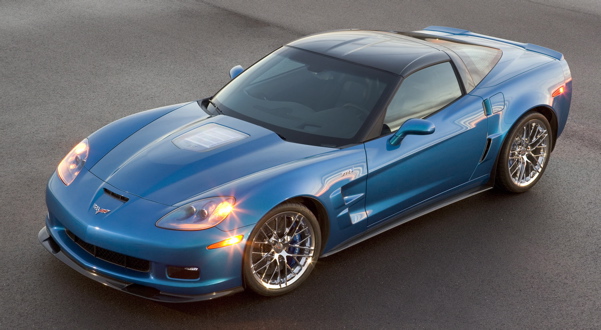
PONTIAC, Mich. – When it arrives next summer, the 2009 Chevrolet Corvette ZR1 will be the most powerful and fastest production car ever produced by General Motors, with performance enabled by a new, supercharged 6.2L LS9 small-block V-8 engine.
Incorporating the engineering experience already found in the Corvette Z06’a LS7 engine and the new-for-2008 6.2L LS3 of the Corvette, GM Powertain is targeting 100 horsepower per liter for the LS9, or 620 horsepower (462 kW), and approximately 595 lb.-ft. of torque (807 Nm); final SAE-certified power levels will be available in early March 2008.
It is, indeed, the ultimate small-block engine for the ultimate Corvette.
“When you experience the LS9 in the Corvette ZR1, the terms performance and refinement take on a new meaning,” said Tom Stephens, group vice president for GM Powertrain and Quality. “The LS9 demonstrates an outstanding performance range, with smooth driveability at low speeds, and surprisingly fierce performance when the customer wants more power.”
The enabler of the LS9’s performance is a new, large positive-displacement Roots-type supercharger – with a unique four-lobe design – developed for the engine by Eaton. It is teamed with an integrated charge cooling system that reduces inlet air temperature for maximum performance. The LS9 represents the first of several new, supercharged small-block engines that will be introduced in GM vehicles in the near future, each using superchargers of similar design.
“The small-block V-8 once again demonstrates it boundless horsepower potential, versatile design and an architecture with proven quality, durability and reliability,” said Stephens. “We haven’t yet realized the small-block’s performance potential.”
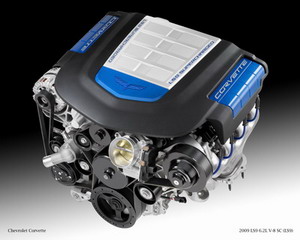
Performance range
More than just its tremendous peak horsepower and torque numbers, the supercharged LS9 makes big power at lower rpm and carries it in a wide arc to 6,600 rpm. GM Powertrain testing shows the engine makes approximately 300 horsepower (224 kW) at 3,000 rpm and nearly 320 lb.-ft. of torque (434 Nm) at only 1,000 rpm. Torque tops 585 lb.-ft. (793 Nm) at about the 4,000-rpm mark, while horsepower peaks at 6,500 rpm. The engine produces 90 percent of peak torque from 2,600 rpm to 6,000 rpm.
Heavy-duty and lightweight reciprocating components enable the engine’s confident high-rpm performance, while the large-displacement Eaton supercharger pushes enough air to help the engine maintain power through the upper levels of the rpm band.
“The sixth-generation design of the supercharger expands the ‘sweet zone’ of the compressor’s effectiveness, broadening it to help make power lower in the rpm band,” said Ron Meegan, assistant chief engineer. “To put it simply, the low-end torque is amazing.”
The LS9 is assembled by hand at GM’s Performance Build Center, a unique, small-volume engine production facility in Wixom, Mich., that also builds the Corvette Z06’s LS7 engine and other high-performance GM production engines.
Cylinder block and reciprocating assembly details
The LS9’s aluminum cylinder block features steel, six-bolt main bearing caps, with enlarged vent windows in the second and third bulkheads for enhanced bay to bay breathing. Cast iron cylinder liners – measuring 4.06 inches (103.25 mm) in bore diameter – are inserted in the aluminum block and they are finish-bored and honed with a deck plate installed. The deck plate simulates the pressure and minute dimensional variances applied to the block when the cylinder heads are installed, ensuring a higher degree of accuracy that promotes maximum cylinder head sealing, piston ring fit and overall engine performance.
Nestled inside the cylinder block is a forged steel crankshaft that delivers the LS9’s 3.62-inch (92 mm) stroke. It features a smaller-diameter ignition-triggering reluctor wheel and a nine-bolt flange – the outer face of the crankshaft on which the flywheel is mounted – that provides more clamping strength. Other non-supercharged 6.2L engines, such as the base Corvette’s LS3, have a six-bolt flange. A torsional damper mounted to the front of the crankshaft features a keyway and friction washer, which also is designed to support the engine’s high loads.
Attached to the crankshaft is a set of titanium connecting rods and forged aluminum pistons, which, when combined with the cylinder heads, delivers a 9.1:1 compression ratio. This combination is extremely durable and lightweight, enabling the LS9’s high-rpm capability.
Cylinder head details
The basic cylinder head design of the LS9 is similar to the L92-type head found on the LS3 V-8, but it is cast with a premium A356T6 alloy that is better at handling the heat generated by the supercharged engine – particularly in the bridge area of the cylinder head, between the intake and exhaust valves.
In addition to the special aluminum alloy, each head is created with a rotocast method. Also known as spin casting, the process involves pouring the molten alloy into a rotating mold. This makes for more even distribution of the material and virtually eliminates porosity – air bubbles or pockets trapped in the casting – for a stronger finished product.
Although the heads are based on the L92 design, they feature swirl-inducing wings that are cast into the intake ports. This improves the mixture motion of the pressurized air/fuel charge. The charge enters the combustion chambers via titanium intake valves that measure 2.16 inches (55 mm) in diameter. Spent gases exit the chambers through 1.59-inch (40.4 mm) hollow stem sodium-filled exhaust valves. The titanium intake and sodium-filled exhaust valves are used for their lightweight and high-rpm capability.
To ensure sealing of the pressurized engine, unique, four-layer steel head gaskets are used with the LS9’s heads.
Camshaft and valvetrain
The broad power band enabled by the LS9’s large-displacement supercharger allows it to make strong low-end torque and great high-rpm horsepower, which allowed engineers to specify a camshaft with a relatively low lift of 0.555-inch (14.1 mm) for both the intake and exhaust valves. This low-overlap cam has lower lift and slower valve-closing speeds than the Z06’s 505-horsepower (377 kW) LS7, helping the LS9 – with its approximately 620 horsepower – deliver exemplary idle and low-speed driving qualities.
The camshaft actuates a valvetrain that includes many components, including the lifters, rocker arms and valve springs, of the LS3 engine. However, LS7 retainers are used to support the engine’s high-rpm performance.
Supercharger and charge cooler details
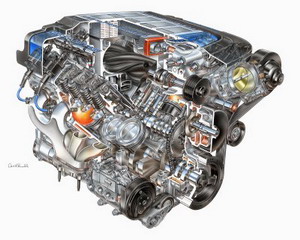 The LS9’s R2300 supercharger is a sixth-generation design from Eaton, with a case that is specific to the Corvette application. The supercharger features a new four-lobe rotor design that promotes quieter and more efficient performance, while its large, 2.3-liter displacement ensures adequate air volume at high rpm to support the engine’s high-horsepower aspiration. Maximum boost pressure is 10.5 psi (0.72 bar).
The LS9’s R2300 supercharger is a sixth-generation design from Eaton, with a case that is specific to the Corvette application. The supercharger features a new four-lobe rotor design that promotes quieter and more efficient performance, while its large, 2.3-liter displacement ensures adequate air volume at high rpm to support the engine’s high-horsepower aspiration. Maximum boost pressure is 10.5 psi (0.72 bar).
The supercharger is an engine-driven air pump that contains a pair of long rotors that are twisted somewhat like pretzel sticks. As they spin around each other, incoming air is squeezed between the rotors and pushed under pressure into the engine – forcing more air into the engine than it could draw under “natural” aspiration. The rotors are driven by a pulley and belt that are connected to the engine’s accessory drive system.
Because the pressurized air is hotter than naturally aspirated air, the LS9 employs a liquid-to-air charge cooling system to reduce inlet air temperature after it exits the supercharger – reducing the inlet air temperature by up to 60 degrees C (140 F). Cooler air is denser and allows the engine to make the most of its high-pressure air charge. The charge cooling system includes a dedicated coolant circuit with a remote-mounted pump and reservoir.
The design of the supercharger case and its integrated charge cooling system was driven by the space and dimensions afforded under the Corvette’s hood. To that end, the charge cooler was designed as a “dual brick” system, with a pair of low-profile heat exchangers mounted longitudinally on either side of the supercharger. Coupled with the supercharger itself, this integrated design mounts to the engine in place of a conventional intake manifold and is only slightly taller than a non-supercharged 6.2L engine. The air inlet and rotor drive pulley are positioned at the front of the supercharger.
Additional engine details
Oiling system: The LS9 uses a dry-sump oiling system that is similar in design to the LS7’s system, but features a higher-capacity pump to ensure adequate oil pressure at the higher cornering loads the ZR1 is capable of achieving. An oil-pan mounted oil cooler is integrated, too, along with piston-cooling oil squirters located in the cylinder block. The expanded performance envelope of the Corvette ZR1 required changes to the dry sump system also used in the Z06. System capacity is increased and scavenge performance improved to meet the demands of Chevrolet’s highest-performance sportscar.
Water pump: To compensate for the heavier load generated by the supercharger drive system, an LS9-specific water pump with increased bearing capacity is used.
Accessory drive system: In order to package the accessory drive system in the Corvette’s engine compartment, the supercharger drive was integrated into the main drive system. This required a wider 11-rib accessory drive system to be used with the LS9 in order to support the load delivered by the supercharger.
Fuel system: The LS9 uses high-capacity 48-lb./hr. fuel injectors with center-feed fuel lines. The center feed system ensures even fuel flow between the cylinders with less noise. In order to ensure fuel system performance during low speed operation as well as under the extreme performance requirements of wide open throttle (WOT), a dual pressure fuel system was developed. This system operates at 250 kPa at idle and low speed, and ratchets up to 600 kPa at higher-speed and WOT conditions.
Throttle body: An 87-mm, single-bore throttle body is used to draw air into the engine. It is electronically controlled.
Rocker covers / ignition coils: Unique rocker covers with new, direct-mount ignition coils are used. Other Gen IV engines, such as the LS3, feature coil packs mounted to a bracket. The LS9’s direct-mounted coils offer a cleaner appearance and a shorter lead between the coil and spark plug.
Beauty cover: A special engine cover is attached to the top of the LS9. It surrounds the intercooler, which is visible through a hood window, accenting the supercharger while simultaneously reducing noise. The cover has “LS9 SUPERCHARGED” script on the left and right sides, along with a debossed Corvette crossed flags emblem on the front.
New six-speed manual transmission
The Corvette ZR1’s LS9 engine is backed by a Tremec TR6060 six-speed manual transmission, with a twin-disc clutch system. It is based on the proven T56 six-speed, but upgraded to handle the LS9’s torque output and delivers improved shift quality
The twin-disc clutch system provides exceptional clamping power, while maintaining an easy clutch effort. The system employs a pair of 260-mm discs, which spreads out the engine’s torque load over a wider area, enabling tremendous clamping power to channel the LS9’s torque. It also dissipates heat better and extends the clutch life (in normal driving).
Thanks to comparatively small plates, the twin-disc system enables similar disc inertia to the Corvette Z06, which has a 290-mm single-disc system, contributing to low shift effort and providing exceptionally smooth engagement and light pedal effort. In fact, the more powerful ZR1 has a pedal effort similar to the Z06.
ZR1-specific gearing in the transmission provides a steep first-gear ratio that helps launch the car. The car’s top speed is achieved in sixth gear – a change from the fifth-gear top-speed run-outs in the manual-transmission Corvette and Corvette Z06. The gears also are designed to balance performance with refinement. The angles of the gear teeth are optimized to provide both strength and quietness.
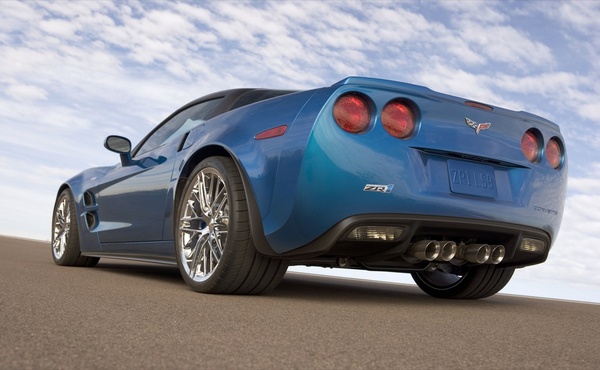
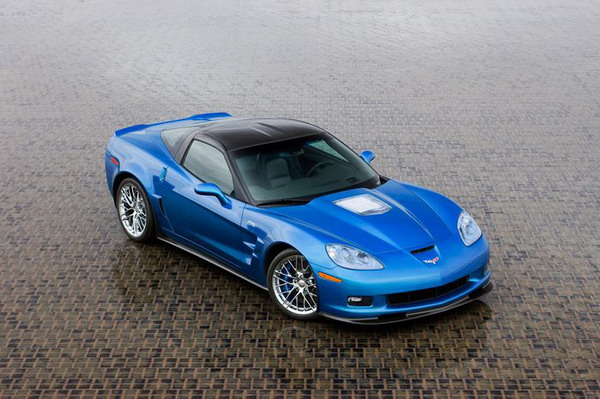
###
Source:
Tom Read and Susan Garavagalia
GM Powertrain Communications


Pingback: sump pumps
Pingback: Air to air heat exchanger
Pingback: pressure washer reviews
I have been waiting to purchase a high powered corvette for a long time. Once I had flown from Detroit to Pittsburgh and had the honors of sitting with a GM rep, this was a year or two ago, as they had just began to release the information on the Camero. He had asked me what I thought of the Camero, as I replied, it needs more horsepower and a heftier price tag. He was shocked and of course asked why a heftier price tag. I told him that in the low 20′s, everyone will have one, if you price it in the low 30′s, only those who truly love the “Camero” will buy it. Now I hope they come out with a Camero SS, ha ha.
I will buy this Corvette, no matter what the price, I am not rich, but, I know beauty and power when I see it, this is rare and the start of a new age.
Oh, and you should stick with the “Blue Devil”!!